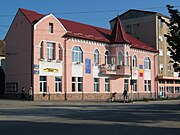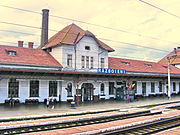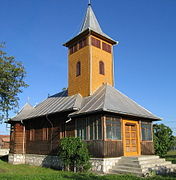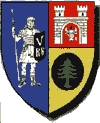Ocna Mureș: Difference between revisions
→Natives: add several more |
→Demographics: more |
||
| (3 intermediate revisions by the same user not shown) | |||
| Line 2: | Line 2: | ||
|type = town |
|type = town |
||
|county = Alba |
|county = Alba |
||
|image_flag = |
|||
|image_shield = ROU AB Ocna Mures CoA1.jpg |
|image_shield = ROU AB Ocna Mures CoA1.jpg |
||
|image_skyline = Roman Catholic church in Marosújvár.jpg |
|image_skyline = Roman Catholic church in Marosújvár.jpg |
||
|image_caption = |
|||
|image_location = |
|||
|image_map = Ocna Mures jud Alba.png |
|image_map = Ocna Mures jud Alba.png |
||
|map_caption = Location in Alba County |
|map_caption = Location in Alba County |
||
| Line 23: | Line 26: | ||
}} |
}} |
||
'''Ocna Mureș''' ({{IPA-ro|ˌokna ˈmureʃ}}; {{lang-la|Salinae}}, {{lang-hu|Marosújvár}}, {{lang-de|Miereschhall}}) is a [[town]] in [[Alba County]], [[Romania]], located in the north-eastern corner of the county, near the [[Mureș River]]. |
'''Ocna Mureș''' ({{IPA-ro|ˌokna ˈmureʃ}}; {{lang-la|Salinae}}, {{lang-hu|Marosújvár}}, {{lang-de|Miereschhall}}) is a [[town]] in [[Alba County]], [[Romania]], located in the north-eastern corner of the county, near the [[Mureș (river)|Mureș River]]. |
||
The town administers five villages: Cisteiu de Mureș (''Magyarcsesztve''), Micoșlaca (''Miklóslaka''), Războieni-Cetate (''Székelyföldvár''), Uioara de Jos (until 1960 ''Ciunga''; ''Csongva''), and Uioara de Sus (''Felsőmarosújvár''). Its former name is ''Uioara'', and was called ''Ocna Mureșului'' from 1925 to 1956. |
The town administers five villages: Cisteiu de Mureș (''Magyarcsesztve''), Micoșlaca (''Miklóslaka''), Războieni-Cetate (''Székelyföldvár''), Uioara de Jos (until 1960 ''Ciunga''; ''Csongva''), and Uioara de Sus (''Felsőmarosújvár''). Its former name is ''Uioara'', and was called ''Ocna Mureșului'' from 1925 to 1956. |
||
==History== |
|||
The spa is again open to the public, due to new investments made by the city and county in a new building with spa, salty basins, medical treatments and sports facilities. |
|||
The town is situated next to a large deposit of salt, mined in the past until the ceiling of the mines collapsed from water infiltration in 1978. Ocna Mureș has a chlorosodic products plant, a salt extraction plant, and a [[destination spa|spa]] which uses the salty water from the former mines. The spa is again open to the public, due to new investments made by the city and county in a new building with spa, salty basins, medical treatments, and sports facilities. |
|||
| ⚫ | The chemical plant in town was lastly purchased by an Indian company from a company based in Timișoara. Currently, the plant has ceased activity and the old buildings were demolished to make room for new enterprises.The majority of high school students attend either Liceul Teoretic Petru Maior or the 'Industrial Highschool,' where many are trained to later work in mechanics, electrical and IT. |
||
| ⚫ | Exceptional students progress onto university studies, generally in nearby [[Cluj-Napoca]] or [[Alba Iulia]], the county capital. The town’s salt mine was flooded in 1978 and the ground became unstable and collapsed |
||
| ⚫ | The chemical plant in town was lastly purchased by an Indian company from a company based in [[Timișoara]]. Currently, the plant has ceased activity and the old buildings were demolished to make room for new enterprises.The majority of high school students attend either Liceul Teoretic Petru Maior or the 'Industrial Highschool,' where many are trained to later work in mechanics, electrical and IT. |
||
| ⚫ | Exceptional students progress onto university studies, generally in nearby [[Cluj-Napoca]] or [[Alba Iulia]], the county capital. The town’s salt mine was flooded in 1978 and the ground became unstable and collapsed. Now this area is filled with more than 4 large, salty and very deep ponds which are projected to become an big natural park. The center of the town and city hall are located at the base of a large hill, the 'Banța.' |
||
== Demographics == |
== Demographics == |
||
| Line 43: | Line 48: | ||
}} |
}} |
||
According to the [[2011 Romanian census|census from 2011]], the town had a total population of 13,036; of those, 83.46% were ethnic [[Romanians]], 9.31% ethnic [[Hungarians in Romania|Hungarians]], and 7% ethnic [[Romani people in Romania|Romani]].<ref>{{cite web|url=http://www.edrc.ro/recensamant.jsp?regiune_id=2568&judet_id=2569&localitate_id=2578|title=Structura Etno-demografică a României|website=Edrc.ro|access-date=8 October 2017}}</ref> At the [[2021 Romanian census|2021 census]], Ocna Mureș had a population of 12,480, of which 80.03% were Romanians, 6.38% Romani, and 6.19% Hungarians.<ref name="RPL2021">{{cite web|url=https://www.recensamantromania.ro/wp-content/uploads/2023/05/Tabel-1.03_1.3.1-si-1.03.2.xls|title=Populația rezidentă după grupa de vârstă, pe județe și municipii, orașe, comune, la 1 decembrie 2021|publisher=[[National Institute of Statistics (Romania)|INSSE]]|language=ro|date=31 May 2023}}</ref> |
|||
== Natives == |
== Natives == |
||
| Line 51: | Line 56: | ||
* [[Rareș Bogdan]] (born 1974), politician, member of the European Parliament |
* [[Rareș Bogdan]] (born 1974), politician, member of the European Parliament |
||
* [[Mihaela Botezan]] (born 1976), long-distance runner |
* [[Mihaela Botezan]] (born 1976), long-distance runner |
||
| ⚫ | |||
* [[Rareș Bogdan]] (born 1974), journalist and politician |
* [[Rareș Bogdan]] (born 1974), journalist and politician |
||
* [[Gheorghe Cacoveanu]] (1935–2001), footballer |
* [[Gheorghe Cacoveanu]] (1935–2001), footballer |
||
* [[Gabriella Csire]] (born 1938), writer |
* [[Gabriella Csire]] (born 1938), writer |
||
* [[Adrian Gongolea]] (born 1975), footballer |
* [[Adrian Gongolea]] (born 1975), footballer |
||
| ⚫ | |||
* [[Bazil Marian]] (1922–2008), football player and coach |
|||
* [[Alexandru Moldovan]] (born 1950), football player and manager |
|||
* [[Ioachim Moldoveanu]] (1913–1981), footballer |
|||
* [[Mircea Stanciu]] (born 1975), footballer |
|||
==Climate== |
==Climate== |
||
Latest revision as of 02:04, 14 January 2024
Ocna Mureș | |
|---|---|
 | |
 Location in Alba County | |
| Coordinates: 46°23′24″N 23°51′36″E / 46.39000°N 23.86000°E | |
| Country | Romania |
| County | Alba |
| Government | |
| • Mayor (2020–2024) | Silviu Vințeler[1] (PNL) |
| Area | 68.34 km2 (26.39 sq mi) |
| Elevation | 208 m (682 ft) |
| Population (2021-12-01)[2] | 12,480 |
| • Density | 180/km2 (470/sq mi) |
| Time zone | EET/EEST (UTC+2/+3) |
| Postal code | 515700 |
| Area code | (+40) 02 58 |
| Vehicle reg. | AB |
| Website | www |
Ocna Mureș (Romanian pronunciation: [ˌokna ˈmureʃ]; Latin: Salinae, Hungarian: Marosújvár, German: Miereschhall) is a town in Alba County, Romania, located in the north-eastern corner of the county, near the Mureș River.
The town administers five villages: Cisteiu de Mureș (Magyarcsesztve), Micoșlaca (Miklóslaka), Războieni-Cetate (Székelyföldvár), Uioara de Jos (until 1960 Ciunga; Csongva), and Uioara de Sus (Felsőmarosújvár). Its former name is Uioara, and was called Ocna Mureșului from 1925 to 1956.
History[edit]
The town is situated next to a large deposit of salt, mined in the past until the ceiling of the mines collapsed from water infiltration in 1978. Ocna Mureș has a chlorosodic products plant, a salt extraction plant, and a spa which uses the salty water from the former mines. The spa is again open to the public, due to new investments made by the city and county in a new building with spa, salty basins, medical treatments, and sports facilities.
The chemical plant in town was lastly purchased by an Indian company from a company based in Timișoara. Currently, the plant has ceased activity and the old buildings were demolished to make room for new enterprises.The majority of high school students attend either Liceul Teoretic Petru Maior or the 'Industrial Highschool,' where many are trained to later work in mechanics, electrical and IT. Exceptional students progress onto university studies, generally in nearby Cluj-Napoca or Alba Iulia, the county capital. The town’s salt mine was flooded in 1978 and the ground became unstable and collapsed. Now this area is filled with more than 4 large, salty and very deep ponds which are projected to become an big natural park. The center of the town and city hall are located at the base of a large hill, the 'Banța.'
Demographics[edit]
| Year | Pop. | ±% |
|---|---|---|
| 1956 | 10,701 | — |
| 1966 | 12,126 | +13.3% |
| 1977 | 16,416 | +35.4% |
| 1992 | 16,256 | −1.0% |
| 2002 | 15,697 | −3.4% |
| 2011 | 13,036 | −17.0% |
| 2021 | 12,480 | −4.3% |
| Source: Census data | ||
According to the census from 2011, the town had a total population of 13,036; of those, 83.46% were ethnic Romanians, 9.31% ethnic Hungarians, and 7% ethnic Romani.[3] At the 2021 census, Ocna Mureș had a population of 12,480, of which 80.03% were Romanians, 6.38% Romani, and 6.19% Hungarians.[4]
Natives[edit]
- Tiberiu Bălan (born 1981), footballer
- János Barlabássy (1482–1560), Hungarian prelate
- Leonard Barlabássy (c.1455–1525), Hungarian nobleman, Vice-voivode of Transylvania from 1501 to 1525
- Rareș Bogdan (born 1974), politician, member of the European Parliament
- Mihaela Botezan (born 1976), long-distance runner
- Rareș Bogdan (born 1974), journalist and politician
- Gheorghe Cacoveanu (1935–2001), footballer
- Gabriella Csire (born 1938), writer
- Adrian Gongolea (born 1975), footballer
- Ovidiu Maier (born 1971), footballer
- Bazil Marian (1922–2008), football player and coach
- Alexandru Moldovan (born 1950), football player and manager
- Ioachim Moldoveanu (1913–1981), footballer
- Mircea Stanciu (born 1975), footballer
Climate[edit]
Ocna Mureș has a humid continental climate (Cfb in the Köppen climate classification).
| Climate data for Ocna Mureș | |||||||||||||
|---|---|---|---|---|---|---|---|---|---|---|---|---|---|
| Month | Jan | Feb | Mar | Apr | May | Jun | Jul | Aug | Sep | Oct | Nov | Dec | Year |
| Mean daily maximum °C (°F) | 1.8 (35.2) |
4.8 (40.6) |
10.4 (50.7) |
16.4 (61.5) |
21 (70) |
24.3 (75.7) |
26.2 (79.2) |
26.4 (79.5) |
21.3 (70.3) |
15.5 (59.9) |
9.4 (48.9) |
3.2 (37.8) |
15.1 (59.1) |
| Daily mean °C (°F) | −2 (28) |
0.2 (32.4) |
5 (41) |
10.9 (51.6) |
15.9 (60.6) |
19.5 (67.1) |
21.3 (70.3) |
21.3 (70.3) |
16.3 (61.3) |
10.5 (50.9) |
5 (41) |
−0.4 (31.3) |
10.3 (50.5) |
| Mean daily minimum °C (°F) | −5.4 (22.3) |
−3.7 (25.3) |
−0.2 (31.6) |
5.2 (41.4) |
10.3 (50.5) |
14 (57) |
15.9 (60.6) |
16.2 (61.2) |
11.6 (52.9) |
6.1 (43.0) |
1.5 (34.7) |
−3.3 (26.1) |
5.7 (42.2) |
| Average precipitation mm (inches) | 35 (1.4) |
33 (1.3) |
47 (1.9) |
70 (2.8) |
94 (3.7) |
112 (4.4) |
108 (4.3) |
94 (3.7) |
73 (2.9) |
55 (2.2) |
41 (1.6) |
43 (1.7) |
805 (31.9) |
| Source: https://en.climate-data.org/europe/romania/alba/ocna-mures-15288/ | |||||||||||||
See also[edit]
References[edit]
- ^ "Results of the 2020 local elections". Central Electoral Bureau. Retrieved 6 June 2021.
- ^ "Populaţia rezidentă după grupa de vârstă, pe județe și municipii, orașe, comune, la 1 decembrie 2021" (XLS). National Institute of Statistics.
- ^ "Structura Etno-demografică a României". Edrc.ro. Retrieved 8 October 2017.
- ^ "Populația rezidentă după grupa de vârstă, pe județe și municipii, orașe, comune, la 1 decembrie 2021" (in Romanian). INSSE. 31 May 2023.







